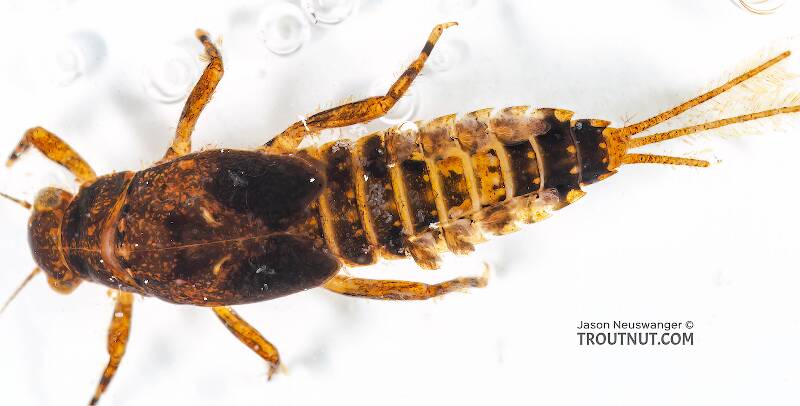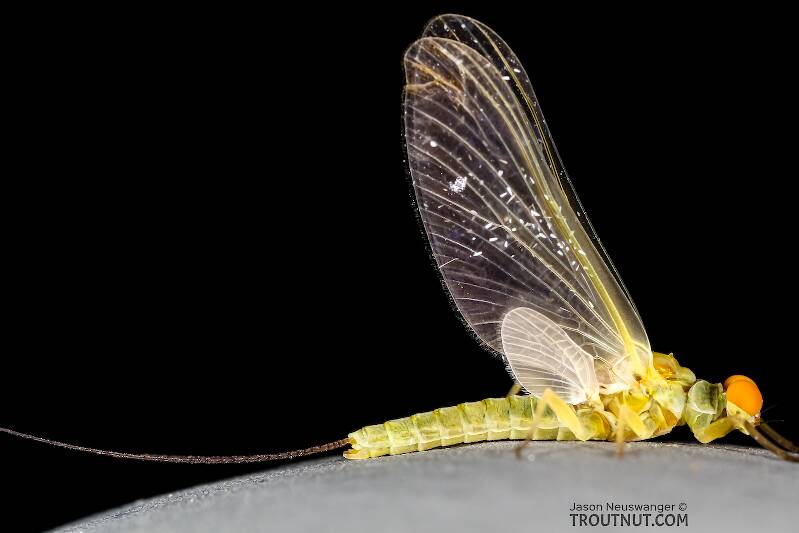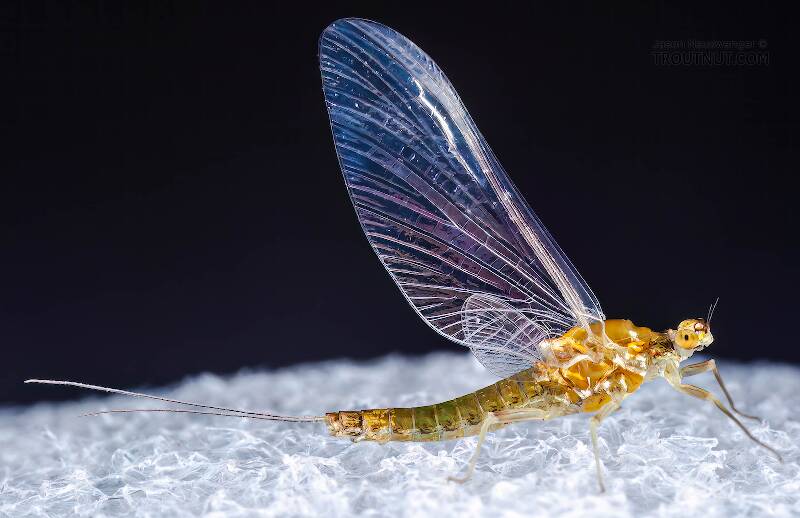
Hex Mayflies
Hexagenia limbata
The famous nocturnal Hex hatch of the Midwest (and a few other lucky locations) stirs to the surface mythically large brown trout that only touch streamers for the rest of the year.
Featured on the forum

It's only barely visible in one of my pictures, but I confirmed under the microscope that this one has a prosternal horn and the antennae are mid-way between the eyes and front of the head capsule.
I'm calling this one Pycnopsyche, but it's a bit perplexing. It seems to key definitively to at least Couplet 8 of the Key to Genera of Limnephilidae Larvae. That narrows it down to three genera, and the case seems wrong for the other two. The case looks right for Pycnopsyche, and it fits one of the key characteristics: "Abdominal sternum II without chloride epithelium and abdominal segment IX with only single seta on each side of dorsal sclerite." However, the characteristic "metanotal sa1 sclerites not fused, although often contiguous" does not seem to fit well. Those sclerites sure look fused to me, although I can make out a thin groove in the touching halves in the anterior half under the microscope. Perhaps this is a regional variation.
The only species of Pycnopsyche documented in Washington state is Pycnopsyche guttifera, and the colors and markings around the head of this specimen seem to match very well a specimen of that species from Massachusetts on Bugguide. So I am placing it in that species for now.
Whatever species this is, I photographed another specimen of seemingly the same species from the same spot a couple months later.
I'm calling this one Pycnopsyche, but it's a bit perplexing. It seems to key definitively to at least Couplet 8 of the Key to Genera of Limnephilidae Larvae. That narrows it down to three genera, and the case seems wrong for the other two. The case looks right for Pycnopsyche, and it fits one of the key characteristics: "Abdominal sternum II without chloride epithelium and abdominal segment IX with only single seta on each side of dorsal sclerite." However, the characteristic "metanotal sa1 sclerites not fused, although often contiguous" does not seem to fit well. Those sclerites sure look fused to me, although I can make out a thin groove in the touching halves in the anterior half under the microscope. Perhaps this is a regional variation.
The only species of Pycnopsyche documented in Washington state is Pycnopsyche guttifera, and the colors and markings around the head of this specimen seem to match very well a specimen of that species from Massachusetts on Bugguide. So I am placing it in that species for now.
Whatever species this is, I photographed another specimen of seemingly the same species from the same spot a couple months later.

Troutnut is a project started in 2003 by salmonid ecologist Jason "Troutnut" Neuswanger to help anglers and
fly tyers unabashedly embrace the entomological side of the sport. Learn more about Troutnut or
support the project for an enhanced experience here.
Pale Morning Spinners
This common name refers to only one species. Click its scientific name to learn more.
Mayfly Species Ephemerella excrucians
These are often called Pale Morning Spinners.
For trout (if not anglers), this single species is arguably the most important mayfly in North America. In terms of sheer numbers, breadth of distribution and hatch duration, it has a good argument.
Ephemerella excrucians or Pale Morning Dun usually follows its larger sibling Ephemerella dorothea infrequens with which it shares the same common name. What it often lacks in size by comparison is made up for with it's duration, often lasting for months with intermittent peaks. This close relationship with infrequens has led many anglers to confuse Pale Morning Dun biology with that of the multivoltine Baetidae species, having disparate broods that decrease in size as the season advances. Sharing the same common name has not helped to alleviate this misconception.
Until recently, Ephemerella excrucians was considered primarily an upper MidWestern species of some regional importance commonly called Little Red Quill among other names. Recent work by entomologists determined that it is actually the same species as the important Western Pale Morning Dun (prev.Ephemerella inermis), and the lake dwelling Sulphur Dun of the Yellowstone area, (prev.Ephemerella lacustris). Since all three are considered variations of the same species, they have been combined into excrucians, being the original name for the type species reported as far back as the Civil War. Angler speculation had simmered for some time that the stillwater loving Ephemerella lacustris was much more widespread, inhabiting more water types then previously thought and could account for many large sulfurish ephemerellids found in still to very slow water locations throughout the West. With the revisions, this discussion is now moot.
Ephemerella excrucians variability in appearance, habitat preferences, and wide geographical distribution are cause for angler confusion with the changes in classification. They can be pale yellow 18's on a large Oregon river, creamy orange 14's on western lakes and feeder streams, large olive green on CA spring creeks as well as tiny sulfur ones in many Western watersheds. Then there's the little Red Quill on small streams in Wisconsin. Yet, all are the same species.
Ephemerella excrucians or Pale Morning Dun usually follows its larger sibling Ephemerella dorothea infrequens with which it shares the same common name. What it often lacks in size by comparison is made up for with it's duration, often lasting for months with intermittent peaks. This close relationship with infrequens has led many anglers to confuse Pale Morning Dun biology with that of the multivoltine Baetidae species, having disparate broods that decrease in size as the season advances. Sharing the same common name has not helped to alleviate this misconception.
Until recently, Ephemerella excrucians was considered primarily an upper MidWestern species of some regional importance commonly called Little Red Quill among other names. Recent work by entomologists determined that it is actually the same species as the important Western Pale Morning Dun (prev.Ephemerella inermis), and the lake dwelling Sulphur Dun of the Yellowstone area, (prev.Ephemerella lacustris). Since all three are considered variations of the same species, they have been combined into excrucians, being the original name for the type species reported as far back as the Civil War. Angler speculation had simmered for some time that the stillwater loving Ephemerella lacustris was much more widespread, inhabiting more water types then previously thought and could account for many large sulfurish ephemerellids found in still to very slow water locations throughout the West. With the revisions, this discussion is now moot.
Ephemerella excrucians variability in appearance, habitat preferences, and wide geographical distribution are cause for angler confusion with the changes in classification. They can be pale yellow 18's on a large Oregon river, creamy orange 14's on western lakes and feeder streams, large olive green on CA spring creeks as well as tiny sulfur ones in many Western watersheds. Then there's the little Red Quill on small streams in Wisconsin. Yet, all are the same species.

I spent a while with a microscope to fairly positively identify this specimen as Ephemerella excrucians.
See 21 more specimens...



